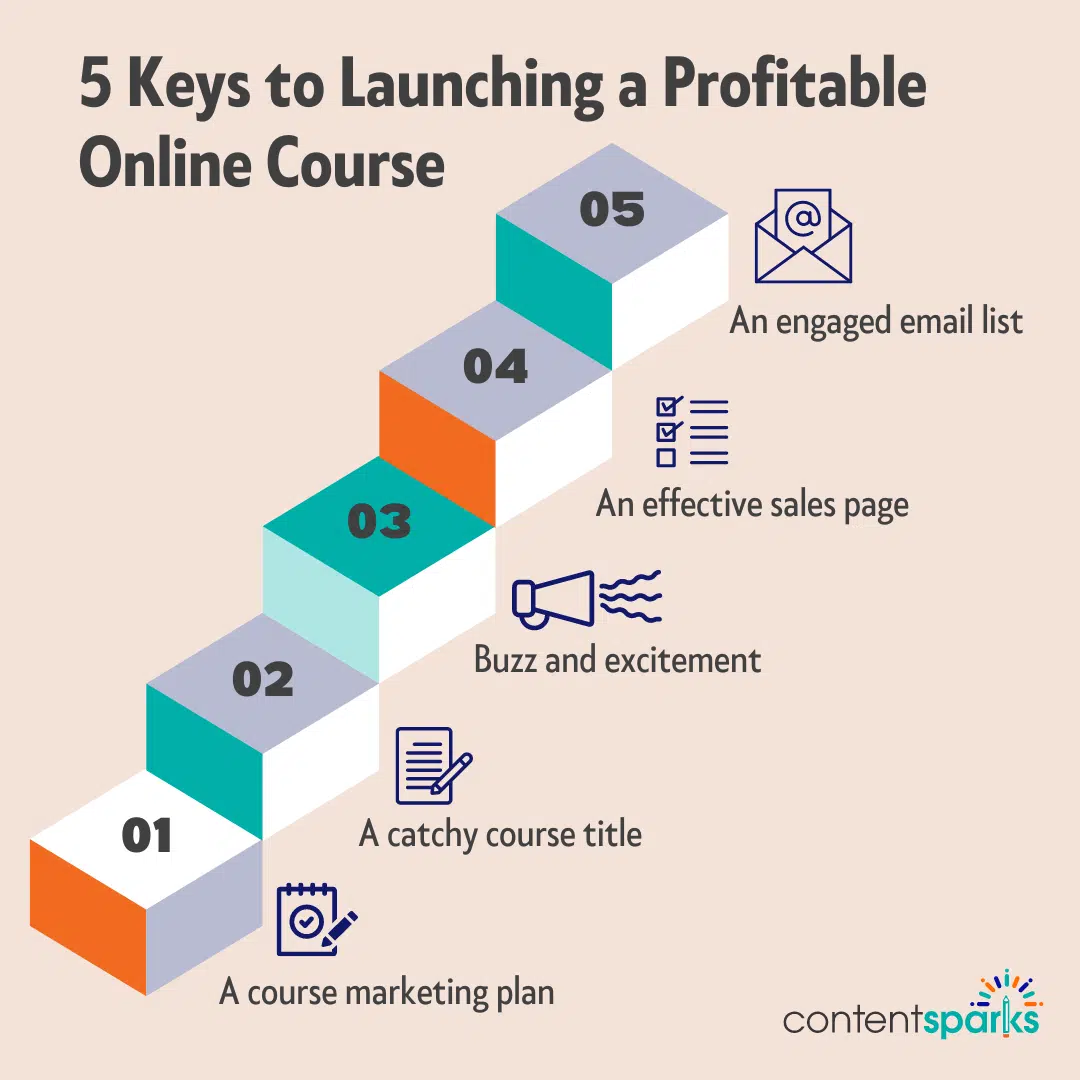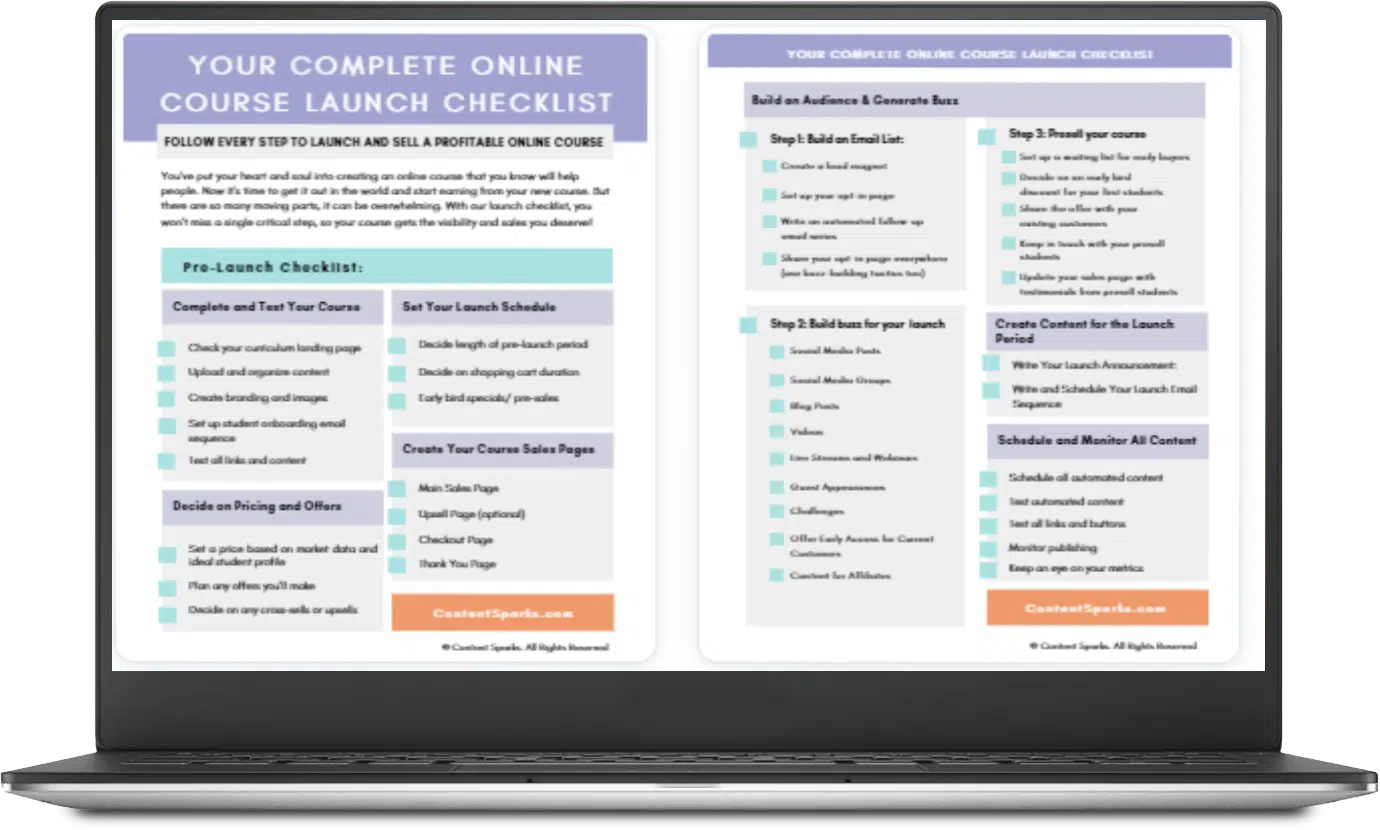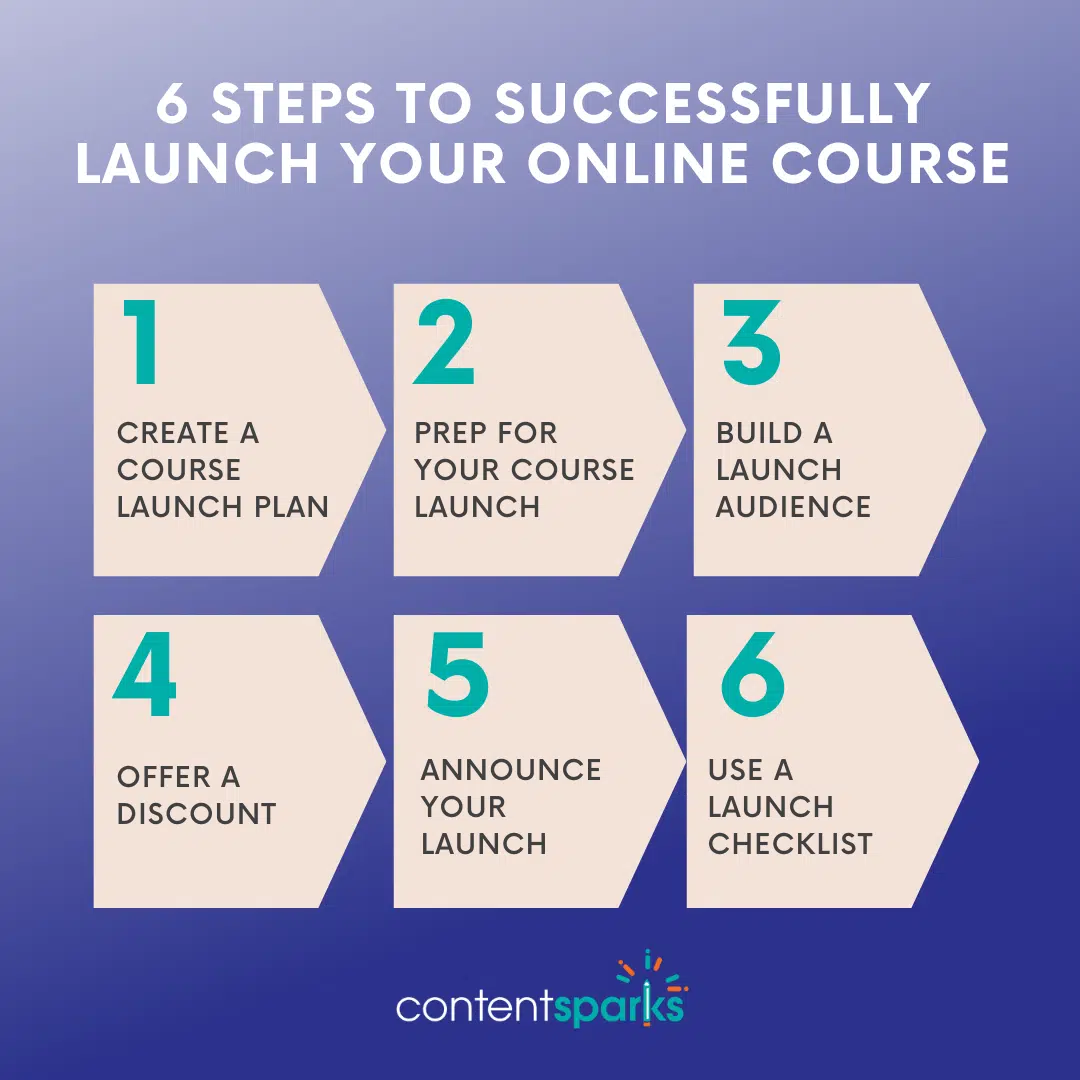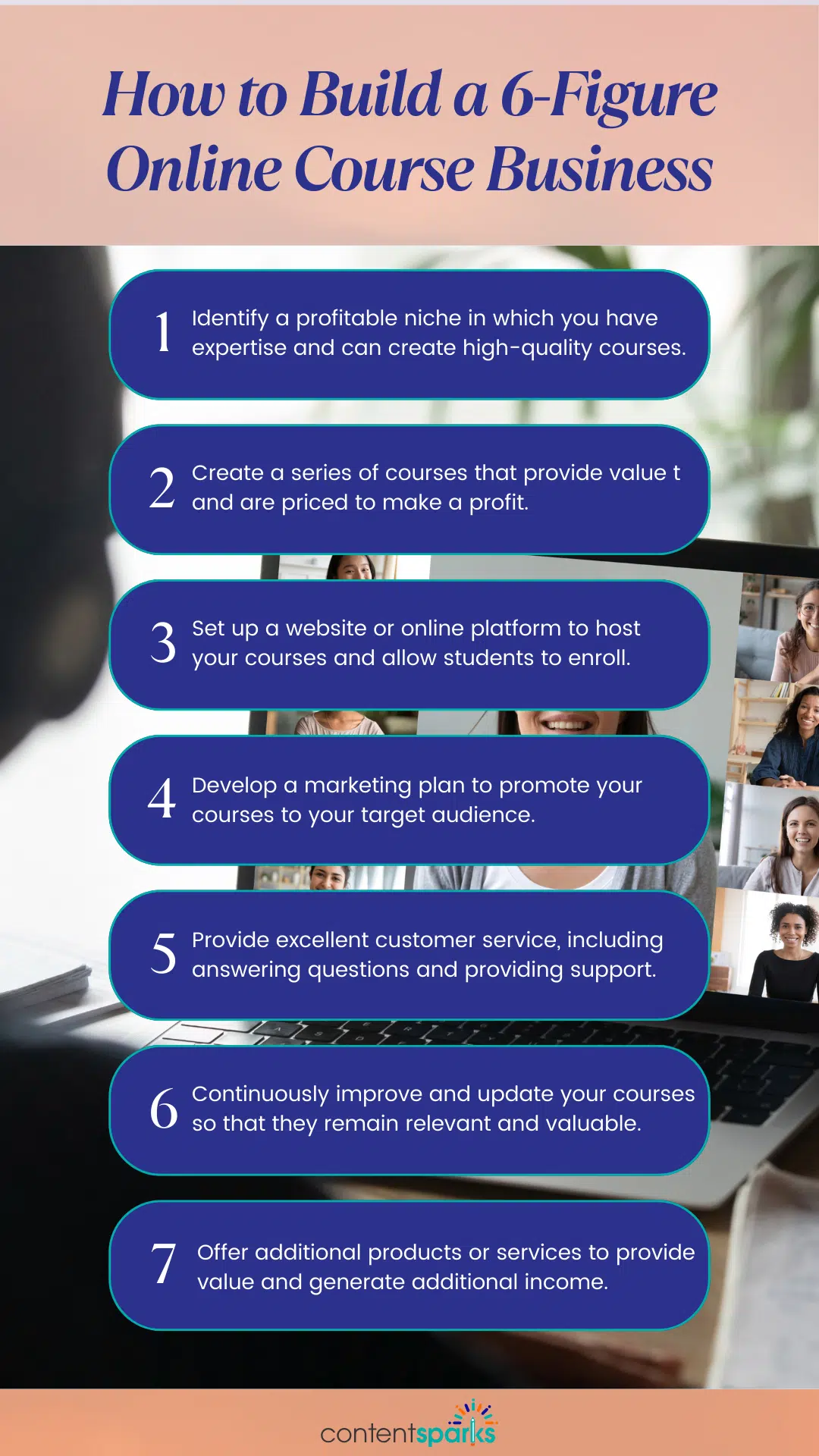No products in the cart.
How to Launch an Online Course [Step-by-Step Guide]
After all the hard work of creating an online course, you’d be tempted to kick back and relax. After all, you’re done, right?
I have some news for you: if you want students to sign up for your course, the fun part is just beginning. But armed with this guide to launch your next online course, there’s nothing stopping you from making your next launch a smashing success.
Creating an online course is a huge achievement, but how do you get the word out to your target market so you can start making sales, enrolling students, and reaping the financial benefits of all your hard work?
Read on as I walk you through my entire launch strategy and best launch tips.
Why You Should Launch an Online Course
If you’ve already set up a successful coaching or consulting business, have numerous clients, and a sparkling reputation, why rock the boat?
Well, in the past few months have you:
If you answered ‘yes’ to any of the above, then it's time to go easier on yourself and create an online course.
Selling an online course is one of the best ways coaches can scale their expertise and grow their business. There’s a myriad of benefits to creating and selling an online course, with my favorites being:
Creating an online course is an excellent way to demonstrate your expertise and scale your business to new heights. Read on for my tried and true course launch process.
When is The Best Time to Launch a Course?
A quick search online will overwhelm you with guides promising the ultimate blueprint of what to launch and when - January for this, February for that, etc.
But is there really a best time of year to launch an online course?
As always, it depends. The best time to launch your course usually hinges on two factors:
Your audience - when will your audience be interested in this topic or more receptive to purchasing the course?
The topic - there are certain times of year when a particular course topic may be more appealing. For example, people may be interested in an SEO course or a course on Google Ads in Q4 as they think about planning for the next year ahead.
Generally speaking, summertime can be tricky for courses oriented toward businesses due to the slowdown that comes with people taking time off for vacations.
Remember, these are just broad brushstrokes. To find your ideal launch time, align these general tendencies with specifics about your course topic and audience. Be prepared to adapt based on feedback, and remember, a successful course launch always involves trial and error, and plenty of flexibility.
5 Keys to Launching a Profitable Online Course
Here are 5 key steps you can take to launch and sell a profitable online course:
A Course Marketing Plan
A good course launch will need an effective plan to market and sell your course.
You'd be shocked at how many business coaches and consultants never create a marketing plan for their online course, even though they tell their clients to do this every day! But without a detailed plan, you run the risk of latching onto the latest shiny marketing strategy, picking the wrong tactics for your market, and wondering why you're not making any sales.
A Catchy Title for Your Course
Your course title is far more important than you can possibly imagine.
If it's too vague or overly clever, your audience will click away without even bothering to take a look. Your title needs to tell people what the course is about, but still be catchy and memorable. If you can include your target audience and branding in the title, even better. It's a tall order, but there are many formulas and title generators you can use to help you brainstorm ideas.
Anticipation and Excitement
Veteran course creators use a proven strategy to ensure they get sales from the very first day of their launches - buzz-building. They educate their audience about the benefits of their course topic, offer a few quick wins (like running a 5-day challenge), and help them see if they need a bigger solution.
To create buzz and anticipation around your online course, you can also use this strategy and start promoting it before you launch. Your tactics can include sharing sneak peeks, teasers, free webinars, a behind-the-scenes look at your course, and building a waiting list or pre-launch group.
An Effective Sales Page
While there are situations where you can sell your course directly from a webinar or presentation, you'll still need a course sales page that converts visitors into customers. Your sales page lives online, either on your online course platform or website, and it's where you send interested prospects.
Make sure your page clearly outlines the benefits and features of your course, and that it provides information on how to enroll. Using a sales page builder, you can also ensure it's well-designed, professional, and easy to navigate.
Email Marketing to Promote Your Course
Start building an email list as soon as possible, especially before your course launch. Then use email to share updates, announce promotions, and provide valuable content that will help build trust and interest among your audience.
It's easy to get lost in the sea of recommended course launch strategies online, so use your judgment and knowledge of your audience to decide on your strategy. Then stick to it consistently until you see success. You can always add or change tactics later.

Before You Launch, Set The Right Price for Your Course
Pricing an online course is one of the trickier aspects of a launch (aside from marketing and selling your course).
If you are brand new to course pricing, check out my complete guide to pricing your next online course. Here are my best tips to get started:
The price point you set will determine what type of launch you run for your course, and how profitable your course will be.
How to Create an Online Course Sales Page That Converts
One of the keys to launching and selling a profitable course is to create a sales page where people can learn about it and enroll. This is another point where coaches and course creators get stuck. What should you put on your page? How should you structure it? How can you make it look professional?
Follow these steps to create an online course sales page that converts:
Here's what a proven course sales page template looks like:
If this is the first sales page you've created, it may take you longer than you'd like. However, the key to making sales of your online course is to have a place for people to pay and enroll. So focus on putting together the minimum of information needed for students to see the benefits and features of your course, along with at least one image. You'll end up editing and adding to your page anyway as you see how it converts, so don't wait until you have the 'perfect' sales page. There's no such thing.

The Ultimate Online Course Launch Checklist
Use this checklist to take action with your online course today!
How to Successfully Launch Your Online Course Step-By-Step
Your course launch is where it all comes together. It's where you announce that your new course is ready for enrollment. Just like with any product launch, those anticipated sales won't show up unless you carefully plan and implement a launch strategy.
Here are six steps you can take to successfully launch your online course:
Create a launch plan
Don't launch your course on the fly, or you'll be floundering around looking for new tactics just when you've started getting people's attention. Create a launch plan that includes all the tasks you need to do before, during, and after your course launch - in detail and with dates attached.
Prepare for your course launch
You'll need a variety of content and systems as part of your launch, so make a list and set all of that up well in advance. Then, during your launch, you can focus your time on engaging with your prospective students.
Your prep work can include creating marketing materials, building a mailing list, and setting up any necessary automation or tools for delivering your course.
Build your audience in advance
Part of your pre-launch activities is building an engaged audience of eager buyers for your course. Then, when you announce that your course is live, you can make sales on Day 1.
In the month before your official opening for enrollments, build excitement about your upcoming course and create a way to directly communicate with your target students. This can include running weekly livestreams on different topics related to your course, offering free content in exchange for email addresses, posting updates with a timer on a 'coming soon' page, or pre-selling spots in your course for a special price.
Offer a limited-time discount or bonus
Everyone loves to feel like they're getting a good deal, and your audience is no exception. To encourage students to enroll in your course, you can offer a limited-time discount when you launch. This could be a percentage off the regular price, a bundle of additional resources or bonuses, or even a 30-minute coaching call with you (best for higher-priced courses). Call it something enticing, like an "Insiders Bonus", "Founders Price", or "Early Access Special".
Announce your course launch
When you're ready to announce that your course is open for enrollment, you have a few channels you can use. These include email, social media, and your website. You can also run paid ads or do free 'quick win' training sessions for other people's audiences (similar to your own). Remember to update your 'coming soon' page too.
Your course launch announcement should include key information about your course, as well as a call to action to enroll.
Use a course launch checklist and calendar
To ensure that you don't forget any important steps in the course launch process, use a course launch checklist and calendar. This can help you stay organized and on track, and make sure that you are prepared for every step of the launch process.
Your course launch doesn't end with the sale. Be sure to add your post-launch activities to your launch plan too. Those should include all of the following:
- Enroll students and onboard (all automated in advance)
- Follow-up with leads for more sales
- Get feedback from students and from people who didn't buy
- Schedule the next launch
Remember to track your metrics too. After your launch is over, look at which tactics and channels resulted in the most enrollments. Then you can tweak your strategy for your next course launch.

How to Launch an Evergreen Course
An evergreen online course can be taken at any time and will always be relevant and up-to-date. This type of course is designed to be timeless so that it can be taken by new students at any point in the future without needing to take time to make frequent revisions.
Anyone who has expertise in a particular subject and wants to share their knowledge with others can create an evergreen online course. This includes educators, professionals, or anyone with a skill or knowledge base that they believe others would benefit from learning.
To create an evergreen online course funnel, you will need to:
The best ways to market an evergreen online course will depend on your target audience and the platform you are using to host your course. Some effective strategies for marketing an evergreen online course include:
You'll notice that many of the steps for creating an evergreen online course are the same as for any course. The biggest difference is that your goal is to reduce the amount of time you spend on your course-building and focus more on marketing.
Evergreen courses are also great candidates for automating parts of your marketing, which will give you more semi-passive income.
How to Build a 6-Figure Online Course Business
You have one course under your belt, so while there is still a while to go to hit six figures you’d be surprised how quickly you can get there.
Building a 6-figure online course business requires a combination of creating a curriculum of high-quality courses, marketing those courses effectively, and providing excellent customer service to your students.
Here are some steps you can take to build a successful online course business:

The key to hitting six figures is having more than one course to sell. That’s because:
Is it possible to build a 6-figure business with just one online course? Yes, but it will require not just a high-quality course, but also dedicated marketing, repeat launches, and excellent customer service.
Most coaches find three or four courses are the perfect base for their online coaching and course academy. You can add new courses a few times a year to grow your library of courses. Especially if you leverage the power of white-label courses like the ones here at Content Sparks, so you don't have to go through all the steps of creating a course from scratch!
And then you can focus your marketing budget on your full range of course options, rather than just one.
That's when you start to not only grow a 6-figure online course business but also scale your coaching business to 7-figures and beyond!
Keeping track of all this and coordinating a course launch is a hefty task. That’s why I created the ultimate course launch checklist for you to download and use in your next course launch.
Click the button below to download the ultimate course launch checklist and watch your next course fly off the (digital) shelf. You’ll get 30% off your next order as a “thank you”, so don’t delay and get that checklist!
Enjoy!
